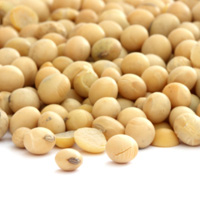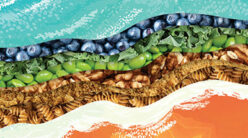Although soybeans have been a staple crop in China for thousands of years, they have come to Western kitchens only in recent years. In 1904 George Washington Carver noted that the soybean is a rich source of protein and oil. By the early 1930s these beans were grown commercially in the United States. Since then they have been widely used to feed livestock and are currently one of the biggest cash crops in America.
Today soy is known as an inexpensive source of protein. Both the Food Guide Pyramid and Nutrition and Your Health: Dietary Guidelines for Americans, fifth ed., list soy foods as a way to meet dietary guidelines. A one-cup (8 oz.) serving of tofu, for example, is listed as a serving suggestion in the meat and beans Group.
Soy’s health claims have been widely publicized by organizations such as the United Soybean Board (USB) and the health food industry. This has led to a dramatic rise in popularity. For example, American sales of soy milk soared from $2 million in 1980 to $300 million by 2000. (Lifestyle magazine, Autumn 2000). Proponents claim that soy lowers the risk of cancer, osteoporosis, and other chronic diseases (Drug Metabolism Drug Interactions;17 2000 (1-4):261-89). Other researchers, however, urge us to proceed with caution. Daniel Doerge and Daniel Sheehan, two research scientists and soy experts with the Food and Drug Administration (FDA), are among those who challenge the presumed benefits of soy (ABC’s 20/20, June 9, 2000; see abcnews.go.com/onair/2020/2020_000609_soy_feature.html. Some of the concerns raised include soy’s effect on brain function in adults, development in infants, and increased risk of breast cancer.
Of particular interest are the estrogen-like isoflavonoid substances found in soy. These plant compounds mimic estrogen, a female hormone that has naturally fluctuating levels during a woman’s life. Cultural observers have noted that Asian women suffer less menopausal distress than American women, and attribute this fact to the diet rich in soy. As a result, phytoestrogens from soy have been used to reduce menopausal symptoms and as a natural alternative to hormone replacement therapy, or HRT, (Obstetrics Gynecology 99, No. 3 Mar. 2202: 389-94). Indeed, intake of certain soy products does alleviate the severity of hot flashes (Climacteric 2, No. 1 Mar. 1999: 6-12). Whether soy foods can provide the same types of benefits as HRT, however, is yet to be determined.
Unfortunately, like HRT, these chemicals can also increase the risk of certain estrogen-dependent cancers, such as breast or ovarian cancer, because they speed up the division of cancer cells that depend on estrogen for their growth (Cancer Research 61, No. 13 July 1, 2001: 5045-50 ; Advances in Experimental Medicine and Biology 492 2001: 19-28). One hundred grams of soy, or two glasses of soy milk a day, has the estrogen simulation effect of a contraceptive pill and can cause changes in a healthy woman’s menstrual cycle.
Another concern is calcium, which is important for bone health. Some say soy milks have less than a fifth of the calcium of dairy milk (see comparison of various milks, at www.tofu.com).
New research is questioning the purported health benefits of soy in adults and raising concerns about adverse effects in children (Environmental Health Perspectives 110, No. 6 June 2002: A294-6). More than one fourth of infant formulas marketed in the U.S. are soy-based, yet it’s not known what effect these chemicals have on normal development. Soy formula provides a hormone level at least 240 times higher than breast milk. If soy products supply sufficient hormones to counteract their natural decline in older women, what are they doing to newborn babies fed soy formula?
On the other hand, dietary soy intake has been shown to have beneficial effects on cardiovascular health (Journal of Nutrition 131, No. 4 April 2001: 1202-6; Journal of Nutrition 132, No. 2 Feb. 2002: 276-82). There’s no evidence, however, that it’s the isoflavones in soy that account for these cardiovascular benefits (Journal of Nutrition 2002 Mar;132(3):566S-569S). The only authorized soy health claim to date is that “25 grams of soy protein a day, as part of diet low in saturated fat and cholesterol, may reduce the risk of heart disease” (U.S. FDA, 2000).
Here are some Web sites to help you understand and use soy products.
- www.soyfoods.org is the home of the Soyfoods Association of North America. Their site is rather technical, created for those involved in the production and promotion of soy foods. One excellent feature is the Soyfoods Facts section. When one clicks on this button, a list of informative, user-friendly fact sheets appears. Each is divided into two columns. The left column explains what the particular soy food (for example, miso, tofu, etc.) is, how it is made, where to find it, five quick ideas to begin using it, and nutritional facts. The right column discusses how it is used in the kitchen and lists a variety of soy cookbooks.
- www.talksoy.com is sponsored by the USB. This volunteer-run organization has become a chief information source for soybean data as well as soy product research and development.The site is extensive, with the pages arranged by type of user: Food Industry, Feed Industry, Health and Nutrition, Media, Consumer, and Industrial Uses. The health and nutrition section has many pages on a number of health topics related to soy, such as women’s health, new medical developments relating to soy health, and soy facts and various conditions such as menopause, cancer, or heart disease. There are ready-made presentations and news items here, too.
The Media and Health and Nutrition sections have links to recipes using soy products. There’s a link to the Soy Glossary, which lists about 200 soy terms. There is also a link to the interactive edition of the organization’s newsletter, The Soy Connection. Overall, I found the site very informative and fairly easy to navigate.
- www.soybean.org is another site sponsored by USB. This site offers descriptions of soy foods, soy nutrition information, recipes, and many FAQs on soy foods and nutrition. There is an abundance of links to other soy sites, but its best resource is the downloadable Soyfoods Guide (pdf format), a full-color, 24-page booklet loaded with nutritional facts and charts. Here you will find tips on cooking various types of soy foods as well as numerous recipes using a variety of soy products.
- www.soyfoods.com has the U.S. Soyfoods Directory. A comprehensive information source about various soy products and recipes, the site includes links to books, research, and other organizations. Also available is a directory of soy foods that meets the new proposed FDA health claim for soy protein. I found this site easy to navigate and user friendly.
- www.tofu.com, home of The World of Tofu, has a great description of how tofu is made and a nutritional chart depicting the differences between soy milk, breast milk, and cow’s milk. The purpose of the site, however, is to sell the two recipe books by William Shurtleff and Akiko Aoyagi, The Book of Tofu and The Book of Miso.
- www.soyonlineservice.co.nz, the Soy Online Service, provides an overview of the subject. Maintained by a group of private citizens with no connection to industry, the site’s mission is to inform the public about soy. They have assembled a collection of articles and research on soy from a variety of popular magazines and media sources, including links to many research studies.







